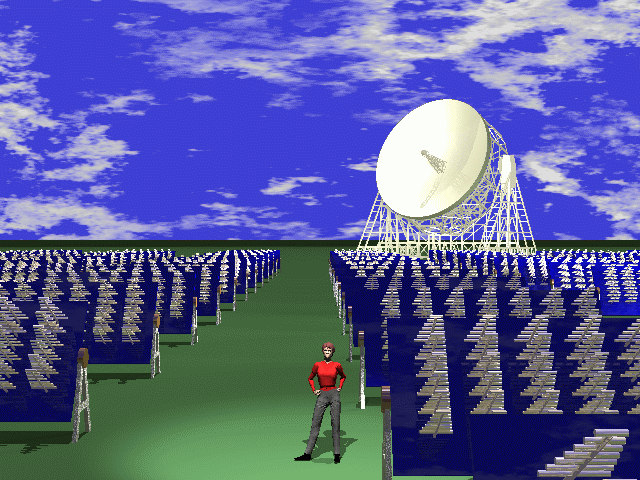Jodrell Bank's SKA Prototype Proposal
A group of University of Manchester (JBO) astronomers including Michael Kramer, Duncan Lorimer, Andrew Lyne and Peter Wilkinson, in collaboration with Graham Woan from the University of Glasgow, have submitted a Statement-of-Interest to the UK Particle Physics and Astronomy Research Council (PPARC) to prepare the ground for a future proposal for the development, installation and operation of a ~5000 m^2 phased array capable of multi-beam operation with a 1-2% bandwidth at 610 MHz. The array is intended to be a 1:200-scale SKA test-bed to demonstrate multi-beam-forming technology appropriate to a mid-frequency (e.g. 150-1500 MHz) concept. An illustration of the array is shown below:

The prototype is designed as a transit instrument but one whose primary beam is quite large. Within this primary beam, covering about 30 square degrees, up to a 1000 beams (5-10 arcmin in diameter) will be synthesised simultaneously.
Our basic approach is to exploit currently available technology and simple, low-cost rf front-ends based on cheap consumer electronics in order to concentrate on the beam-forming technology which we want to implement completely in software. The computing power for the back-end will also apply largely consumer electronic in a PC-cluster. As a result, the proposed telescope will be a low-cost, low-maintenance instrument that, for about GBP 1.0M, is effectively equivalent to about a thousand (depending on the number of independent beams created) Lovell telescopes operating simultaneously! As such, it will deliver unique science ranging from pulsar astrophysics, cosmological studies of highly redshifted hydrogen, interplanetary scintillation, to searches of the transient sky.
As front-ends the phased array will make use of cost-effective commercial twin-polarized TV (yagi) antennae, which will be combined to form individual (about 30 m^2) arrays (patches) by adding the received signals in phase using r.f. cables. This is merely for practical reasons to reduce the computing requirements.
The patch size sets the size of the primary beam. The patches will be mechanically pointed towards the Southern meridian to maximise the effective collective area for a particular declination range. The declination will be manually adjustable.
The back-end will require hardware for sampling and digitization of the rf signals which will then be fed into the large-scale Beowulf-cluster where all the beam-forming and data processing will be carried out. A 182-node Beowulf-cluster is already in successful operation at JBO as the heart of the innovative pulsar back-end COBRA. The cluster envisaged for the prototype array will be several times more powerful than this.
The emerging philosophy is that of a "software" telescope array which rides on the back of consumer electronics and Moore's Law, for continuously enhancing the commercially-available computing power and hence the beam-forming and data processing capability. By restricting the array to transit operation costs may be further held down but the concept is still well-suited to first-ranked surveying and monitoring/timing programmes as mentioned above.


